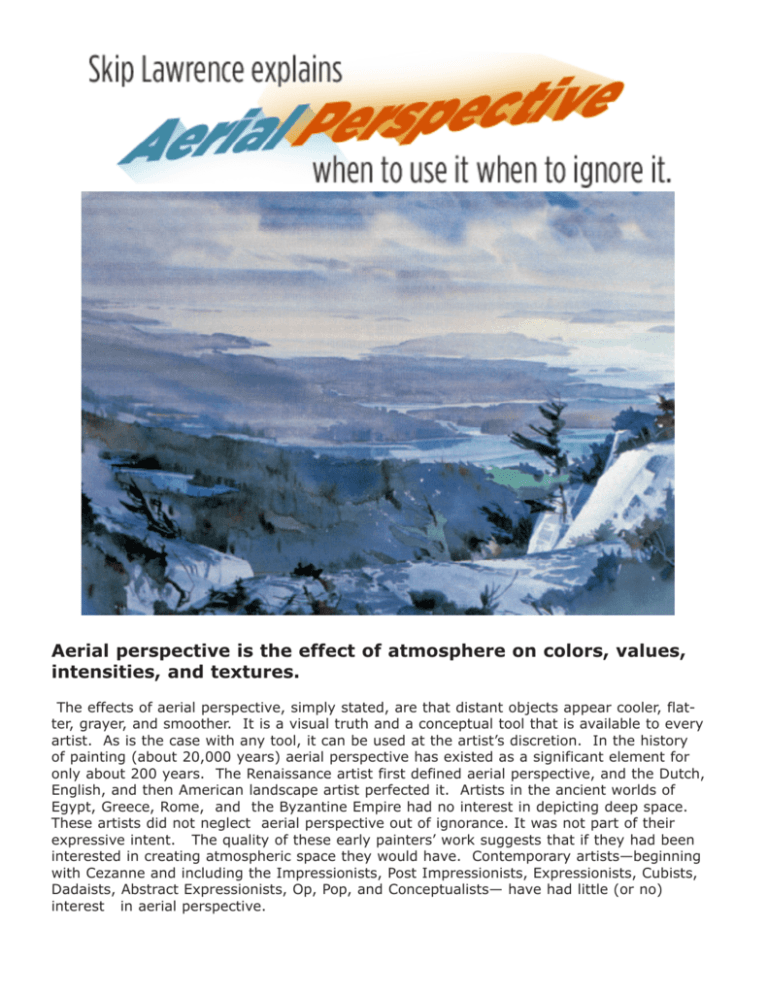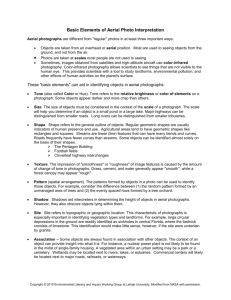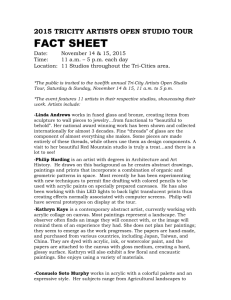Aerial perspective is the effect of atmosphere on colors, values
advertisement

Aerial perspective is the effect of atmosphere on colors, values, intensities, and textures. The effects of aerial perspective, simply stated, are that distant objects appear cooler, flatter, grayer, and smoother. It is a visual truth and a conceptual tool that is available to every artist. As is the case with any tool, it can be used at the artist’s discretion. In the history of painting (about 20,000 years) aerial perspective has existed as a significant element for only about 200 years. The Renaissance artist first defined aerial perspective, and the Dutch, English, and then American landscape artist perfected it. Artists in the ancient worlds of Egypt, Greece, Rome, and the Byzantine Empire had no interest in depicting deep space. These artists did not neglect aerial perspective out of ignorance. It was not part of their expressive intent. The quality of these early painters’ work suggests that if they had been interested in creating atmospheric space they would have. Contemporary artists—beginning with Cezanne and including the Impressionists, Post Impressionists, Expressionists, Cubists, Dadaists, Abstract Expressionists, Op, Pop, and Conceptualists— have had little (or no) interest in aerial perspective. What are you trying to say? It’s a matter of intent. Any painting done at any time is a reflection of the artist’s intent— how he personally responds to the subject before him. Two painters stand before a landscape. One sees a vast expanse of space that disappears at the horizon. The other sees a deep blue-green sky which touches a rusted tin roof. One must utilize the laws of aerial perspective to portray that which he finds compelling. (For example, Brian Atyeo in his striking painting on the preceding page depicted the effects of aerial perspective to convey a feeling of the vast, uninhabitated landscape of northern Canada.) The other must disregard the rules of aerial perspective in order to achieve the desired effect. One sees space; the other sees color. It is fun to imagine how two artists as different as John Constable and Paul Cezanne might treat the same subject. Constable would make a distant mountain look like it was twelve miles away; Cezanne would put it right up in front of your nose. Here’s an exercise: Take one of your old paintings that employs aerial perspective to depict deep space and repaint it. Here, in my traditional version of Mt. Ste. Victoire I’ve observed that the distant mountain appears cooler, grayer, and with no value contrasts, or texture and I painted it accordingly. I’ve made the foreground elements warmer, stronger in value contrast and more detailed. If you have an old painting that looks like this, try it again as I’ve done below. Try redesigning your painting as I’ve done in this version. Here, I’ve ignored the effects of aerial perspective in order to emphasize shape and color relationships. I’ve changed the scale of the mountain and given equal treatment to the value contrasts, color, intensity and surface detail to both distant and close-up objects. If you have trouble doing this, try turning your painting upside down or sideways. Forget that the mountain is far away. If you can produce a beautiful painting, nobody will care. If you don’t need it, don’t use it The use and knowledge of aerial perspective is invaluable to the painter whose intent is to create and define depth of space. The use of aerial perspective when space is not the passion of the artist is harmful, at least,and many times devastating. I want you to understand that you are not obligated under the “rules of painting” or any other authority to paint distant mountains as cooler, flatter, grayer, or smoother. All too often I hear students say that the reason they used blue was “the shape was farther back.” The appeal of aerial perspective, or any such rule, is that it is absolute. Absolutes imply that, if followed, success is insured. Oh, that it was that easy! We must always remember that art is not science. Paul Cezanne is called the “father of modern art” because he wouldn’t have cared about where Mount Sainte Victoire existed in space ; it interested him only as a shape and color. “Into the Woods” by Skip Lawrence Watercolor on paper, 22”x30”








